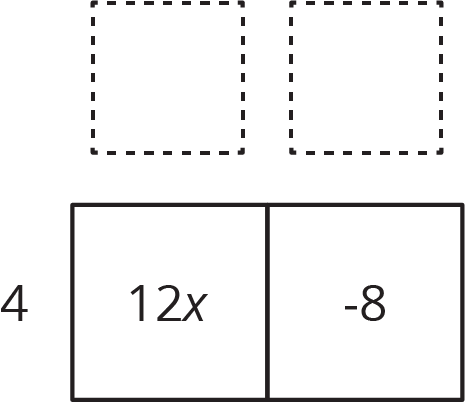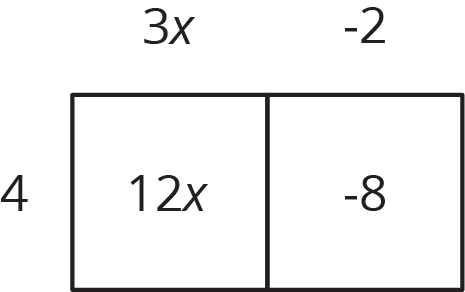Lesson 8
Expanding and Factoring
8.1: Number Talk: Parentheses (10 minutes)
Warm-up
The purpose of this number talk is to remind students that when we evaluate expressions, we multiply before we add or subtract. Parentheses are used to indicate that the order should be different. Remembering how this works will be important for an activity in this lesson.
Launch
Display one problem at a time. Give students 30 seconds of quiet think time for each problem and ask them to give a signal when they have an answer and a strategy. Keep all problems displayed throughout the talk. Follow with a whole-class discussion.
Supports accessibility for: Memory; Organization
Student Facing
Find the value of each expression mentally.
\(2 + 3 \boldcdot 4\)
\((2+3)(4)\)
\(2 - 3 \boldcdot 4\)
\(2 - (3 + 4)\)
Student Response
For access, consult one of our IM Certified Partners.
Activity Synthesis
The second question is an opportunity to remind students that “next to” implies “multiply.” The second expression could be rewritten \((2+3) \boldcdot 4\). Point out that we can also know that the second expression is 20 by using the distributive property: \(2 \boldcdot 4 + 3 \boldcdot 4\).
The fourth expression could also be rewritten \(2-3-4\).
Ask students to share their strategies for each problem. Record and display their responses for all to see. To involve more students in the conversation, consider asking:
- “Who can restate ___’s reasoning in a different way?”
- “Did anyone have the same strategy but would explain it differently?”
- “Did anyone solve the problem in a different way?”
- “Does anyone want to add on to _____’s strategy?”
- “Do you agree or disagree? Why?”
Design Principle(s): Optimize output (for explanation)
8.2: Factoring and Expanding with Negative Numbers (20 minutes)
Activity
This activity is an opportunity for students to practice rewriting expressions using the distributive property. It is a step up from the same type of work in grade 6 because arithmetic with signed numbers is required.
The row with \(6a-2b\) is designed to allow students to figure out how to factor by reasoning based on structure they already understand, instead of learning how to factor based on a procedure that a teacher demonstrates first. The rows with \(k(4 - 17)\) and \(10a-13a\) are designed to prepare students for combining like terms in the next lesson.
Launch
Draw students’ attention to the organizers that appear above the table, and tell them that these correspond to the first three rows in the table. Let them know that they are encouraged to draw more organizers like this for other rows as needed.
Arrange students in groups of 2. Instruct them to take turns writing an equivalent expression for each row. One partner writes the equivalent expression and explains their reasoning while the other listens. If the partner disagrees, they work to resolve the discrepancy before moving to the next row.
Supports accessibility for: Language; Organization
Student Facing
In each row, write the equivalent expression. If you get stuck, use a diagram to organize your work. The first row is provided as an example. Diagrams are provided for the first three rows.

| factored | expanded |
|---|---|
| \(\text- 3(5 - 2y)\) | \(\text- 15 + 6y\) |
| \(5(a-6)\) | |
| \(6a-2b\) | |
| \(\text- 4(2w-5z)\) | |
| \(\text- (2x-3y)\) | |
| \(20x-10y+15z\) | |
| \(k(4-17)\) | |
| \(10a-13a\) | |
| \(\text- 2x(3y-z)\) | |
| \(ab-bc-3bd\) | |
| \(\text- x(3y-z+4w)\) |
Student Response
For access, consult one of our IM Certified Partners.
Student Facing
Are you ready for more?
Expand to create an equivalent expression that uses the fewest number of terms: \(\left(\left(\left(\left(x\strut+1\right)\frac12\right)+1\right)\frac12\right)+1\). If we wrote a new expression following the same pattern so that there were 20 sets of parentheses, how could it be expanded into an equivalent expression that uses the fewest number of terms?
Student Response
For access, consult one of our IM Certified Partners.
Anticipated Misconceptions
If students are unsure how to proceed, remind them of tools and understandings they have seen recently that would be helpful. For example, “Draw an organizer and think about how the organizer represents terms in the expression.” Also, “Rewrite subtraction as adding the opposite.”
Activity Synthesis
Much of the discussion will take place in small groups. Display the correct equivalent expressions and work to resolve any discrepancies. Expanding the term \(\text-(2x-3y)\) may require particular care. One way to interpret it is to rewrite as \(\text-1 \boldcdot (2x-3y).\) If any confusion about handling subtraction arises, encourage students to employ the strategy of rewriting subtraction as adding the opposite.
To wrap up the activity, ask:
- “Which rows did you and your partner disagree about? How did you resolve the disagreement?”
- “Which rows are you the most unsure about?”
- “Describe a process or procedure for taking a factored expression and writing its corresponding expanded expression.”
- “Describe a process or procedure for taking an expanded expression and writing its corresponding factored expression.”
Design Principle(s): Maximize meta-awareness
Lesson Synthesis
Lesson Synthesis
- To write an equivalent expression by factoring means to use the distributive property to write a sum as a product.
- To write an equivalent expression by expanding means to use the distributive property to write a product as a sum.
Ask students to give an example of each.
8.3: Cool-down - Equivalent Expressions (5 minutes)
Cool-Down
For access, consult one of our IM Certified Partners.
Student Lesson Summary
Student Facing
We can use properties of operations in different ways to rewrite expressions and create equivalent expressions. We have already seen that we can use the distributive property to expand an expression, for example \(3(x+5) = 3x+15\). We can also use the distributive property in the other direction and factor an expression, for example \(8x+12 = 4(2x+3)\).
We can organize the work of using distributive property to rewrite the expression \(12x-8\). In this case we know the product and need to find the factors.
The terms of the product go inside:

We look at the expressions and think about a factor they have in common. \(12x\) and \(\text- 8\) each have a factor of 4. We place the common factor on one side of the large rectangle:

Now we think: "4 times what is 12\(x\)?" "4 times what is -8?" and write the other factors on the other side of the rectangle:

So, \(12x-8\) is equivalent to \(4(3x-2)\).